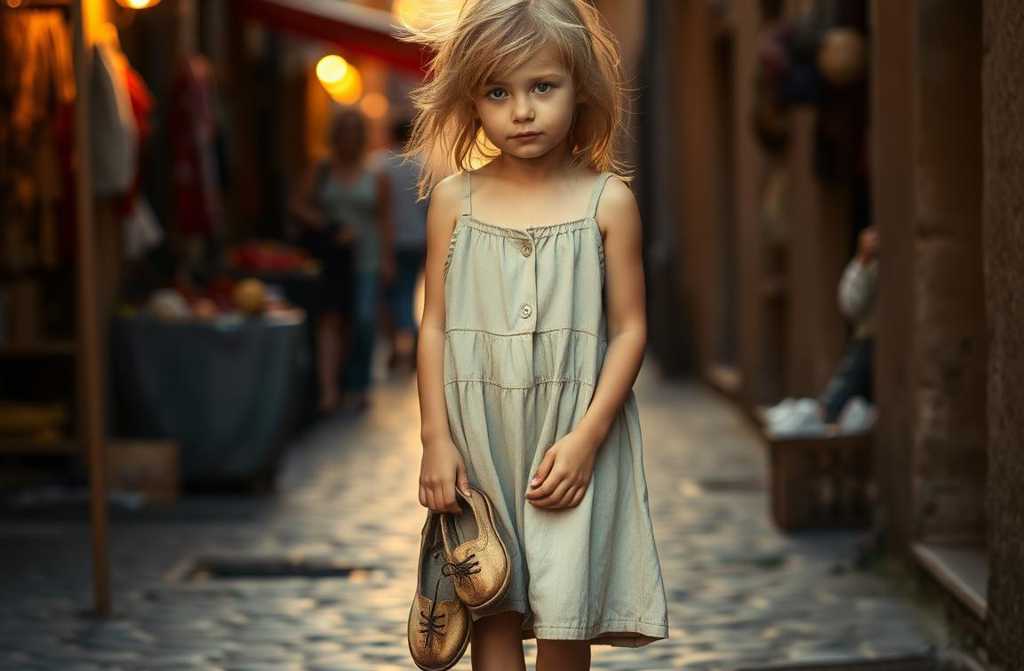З життя
Starlight Shoes: The Legendary Footwear of Dreams

**Star’s Shoes**
Star was eleven years old and walked barefoot along the cobbled streets of Canterbury. Every stone, every crack beneath her feet whispered tales of centuries pastof bustling markets, laughter, and hurried footsteps. Her mother wove bracelets for tourists, threads of colour catching the sunlight, while her father sold roasted chestnuts, their sweet, smoky scent filling the crisp air. They werent poor in spirit, but money barely stretched to cover essentials. Nights were cold, and sometimes the fire in the hearth did little to warm the room where she and her two brothers slept.
Sometimes Star went to school, trudging miles with a heavy backpack and the hope of learning something new. Other days, she couldnt goher mother needed help with the bracelets, or her baby brother, who hadnt yet found his words but whose giggles and babbles lit up the day, needed looking after.
One evening, as the sun dipped low over the town square, a foreign woman noticed Star darting between market stalls, her feet dusty and bruised. The lady approached with a kind smile and asked why she wasnt wearing shoes. Star shrugged, her gaze dropping to the ground.
“Mine broke months ago,” she murmured. “We cant afford new ones.”
Touched by her honesty, the woman rummaged in her bag and pulled out a pair of nearly new trainerswhite with a blue lightning stripe down the side. To Star, they shimmered like treasure. That night, she refused to take them off, placing them carefully beside her bed as if they might vanish by morning.
The next day, she wore them to school, head held high. Not out of pride, but dignity. For the first time, she didnt feel the need to tuck her feet beneath the bench, ashamed. Every step felt solid, as if something inside her had shifted.
But soon, whispers followed.
“Look at posh Star with her fancy shoes!” a classmate sneered.
The laughter stung more than walking barefoot ever had. The words were knives, slicing through her chest, reminding her that even with something beautiful, the world could still be cruel. That afternoon, Star tucked the trainers into a bag, hiding them away.
“Whats wrong, love?” her mother asked.
“Just keeping them safe, Mum,” Star lied.
She couldnt explain how being poor and owning something nice sometimes hurt more than having nothing. How kindness could be mistaken for arrogance. How humility wasnt about what you wore, but how you carried yourselfeven when others judged.
Days later, a charity arrived in the village. They were photographing children for an exhibition on rural childhood in England, capturing the quiet beauty of their livesgames, chores, the way tradition wove into everyday moments. Star was chosen. They photographed her in those trainers, standing outside their brick-and-thatch cottage, holding a wildflower shed picked. Every detail told a story: the cobblestones, her mothers work-worn hands, her little brothers curious gaze in the background.
The photo travelled farto London, Edinburgh, even New York. People called it a symbol of resilience, innocence, and unpolished beauty. Star knew nothing of it until a journalist came looking for her.
“Your pictures in a gallery,” he said. “People want to know about the girl with the bright eyes and white trainers.”
Star glanced at her mother, who wept silentlyproud but afraid of the attention now turned on her daughter.
“Why would they care about me?” Star asked, bewildered.
“Because you represent something powerful,” the journalist replied. “That even the simplest things, when seen with respect, become art.”
That day, Star understood the shoes werent a sign of wealth, but of being seen. That any girl, no matter where she came from, deserved to be noticed.
She slipped the trainers back on and walked through the square without lowering her head. The taunts didnt matter anymore. Every step reminded her that beauty wasnt just what others sawit was the courage to stop hiding. The admiring glances, the nods from neighbours, all strengthened her.
Star began to walk taller. To notice the colours of the hedgerows, the swoop of swallows, the games of children weaving through the market. She learned she had every right to be there, that her place in the world didnt depend on anyones approval.
The classmates whod mocked her slowly saw her differently. Some even asked about the shoes, about how it felt to wear them.
“Theyre not magic,” shed say. “Just a reminder I can walk without fearthat I can look in the mirror and feel strong, even when lifes hard.”
Her story became an example for other village children. They began taking pride in what they had, without envy or imitation. Parents noticed a changea spark of quiet confidence, not in wealth, but in self-respect.
The exhibition moved visitors, too. Strangers marvelled at how something so ordinary could tell such a profound story. Stars photo became a symbolof dignity in hardship, of how small gestures could shift the way the world saw you.
In time, Star learned to value lifes gifts beyond the shoes. Kindness didnt always come as moneysometimes it was a chance, a glance, a moment of being seen. She realised walking with dignity wasnt about what you wore, but how you faced the world.
A pair of trainers might not change the world, but they could change how a child saw herself. And thatthat was something close to a miracle.
With every step Star took on those ancient cobbles, the white-and-blue trainers gleamed under the sun, a reminder that beauty and strength could bloom in the humblest places. That sometimes, the most powerful art grew from the everydaythe simple, the true.

















